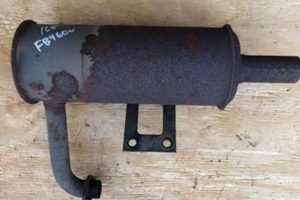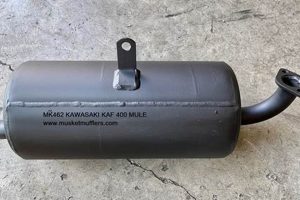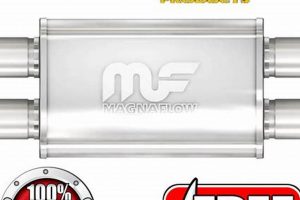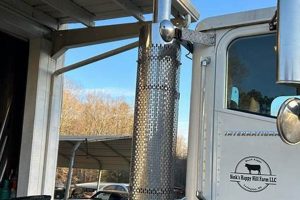The selection of an appropriate exhaust component significantly impacts the performance characteristics of a 6.0 Vortec engine. This component, typically installed as part of the exhaust system, plays a critical role in managing engine noise and backpressure. Its design influences factors such as horsepower, torque, and overall engine efficiency. Aftermarket options vary significantly in construction, materials, and internal baffling configurations, each influencing sound characteristics and performance outcomes.
Proper exhaust flow management is essential for optimizing engine output and fuel economy. A well-chosen system can enhance power, particularly at certain RPM ranges, and improve the driving experience through adjusted sound profiles. Historically, advancements in muffler technology have led to improvements in both performance and sound control, allowing vehicle owners to tailor their exhaust systems to specific needs and preferences.
The following sections will delve into the different types available, factors to consider when making a choice, and examples of commonly used systems for the 6.0 Vortec engine, providing a basis for informed decision-making.
Selection Considerations for Optimal Performance
Choosing an appropriate exhaust component for a 6.0 Vortec engine requires careful evaluation to ensure desired performance characteristics and sound profiles are achieved.
Tip 1: Evaluate Engine Usage: Determine the primary use of the vehicle (e.g., towing, daily commuting, off-road). This dictates the desired power band and permissible noise levels. For towing applications, focus on low-end torque enhancement.
Tip 2: Consider Material Durability: Stainless steel options offer superior corrosion resistance compared to aluminized steel, particularly in regions with harsh weather conditions. This extends the lifespan of the exhaust system.
Tip 3: Analyze Internal Design: Different internal baffling designs (e.g., chambered, straight-through, turbo) influence both noise reduction and exhaust flow. Straight-through designs typically offer better flow and louder sound.
Tip 4: Research Sound Level Requirements: Investigate local noise ordinances to ensure compliance. Certain jurisdictions have decibel limits that must be adhered to. Consider a quieter system if noise restrictions are a concern.
Tip 5: Assess Installation Complexity: Determine whether professional installation is necessary based on mechanical skill level and available tools. Some systems may require welding or specialized equipment.
Tip 6: Examine Backpressure Effects: Be mindful of the potential effects of backpressure on engine performance. Excessive backpressure can reduce horsepower, while insufficient backpressure can impact low-end torque. Aim for a balance appropriate for the engine’s operational range.
Tip 7: Verify Compatibility: Ensure the chosen exhaust component is specifically designed for the 6.0 Vortec engine and compatible with the vehicle’s make and model. This avoids fitment issues and ensures proper exhaust routing.
Careful attention to these factors will result in an optimal match, delivering the desired performance improvements and sound characteristics.
The subsequent sections will explore specific examples and provide a guide to understanding the technical specifications involved in this critical selection.
1. Sound Level (Decibels)
The sound level, measured in decibels (dB), is a critical characteristic of any exhaust system component designed for a 6.0 Vortec engine. The choice of a component directly influences the vehicle’s acoustic profile and affects both the driver’s experience and potential compliance with local noise regulations. Higher decibel levels typically correlate with less restrictive internal designs, which can improve exhaust flow and potentially enhance horsepower, particularly at higher engine speeds. However, these systems often produce a louder, more aggressive sound, potentially unsuitable for residential areas or drivers seeking a quieter experience. Conversely, exhaust components with lower dB ratings generally incorporate more restrictive baffling, which reduces noise levels but may also limit exhaust flow and slightly reduce power output.
A practical example illustrates this point: A straight-through system may register around 95-100 dB at wide-open throttle, offering a noticeable performance gain but potentially exceeding noise limits in some municipalities. A chambered system, designed for quieter operation, might measure 85-90 dB under similar conditions, sacrificing some performance potential for reduced noise. This trade-off necessitates careful consideration of intended use and legal restrictions. Failure to account for sound levels can result in fines or the need for costly modifications to achieve compliance.
In summary, the sound level, as measured in decibels, forms an integral consideration in selecting the optimal exhaust component for a 6.0 Vortec engine. The relationship between sound level, internal design, and performance must be carefully weighed against regulatory requirements and personal preferences. Choosing appropriately requires understanding the impact of internal design characteristics on the resulting sound output and their potential consequences regarding both performance and legal compliance.
2. Flow Rate (CFM)
Flow rate, measured in cubic feet per minute (CFM), constitutes a critical specification in evaluating exhaust components for a 6.0 Vortec engine. It reflects the volume of exhaust gases that can pass through the component within a given time, thereby directly influencing engine performance. Optimizing this aspect is paramount when seeking a component that enhances power delivery and overall engine efficiency.
- Impact on Horsepower and Torque
Higher CFM values generally correlate with reduced backpressure within the exhaust system. This reduction allows the engine to expel exhaust gases more efficiently, translating to increased horsepower, particularly at higher engine speeds. Conversely, excessively high flow rates without sufficient backpressure can negatively impact low-end torque. The ideal component optimizes flow without sacrificing the backpressure necessary for low-speed performance. A component suitable for a high-performance application might prioritize CFM, while a towing application would benefit from a balance that favors low-end torque.
- Influence of Internal Design
The internal design significantly affects CFM. Straight-through designs typically offer higher flow rates due to their minimal obstruction. Chambered and baffled designs, while effective at reducing noise, inherently restrict flow to some extent. Therefore, understanding the internal construction is vital in predicting the component’s CFM characteristics. Some manufacturers provide CFM ratings, allowing for direct comparison. However, independent testing may be necessary to verify these claims and assess real-world performance.
- Consideration of Engine Modifications
Engine modifications, such as aftermarket headers or performance camshafts, increase exhaust gas volume. In such cases, a component with a higher CFM rating becomes even more critical to accommodate the increased flow. Failure to upgrade the component to match the modifications can create a bottleneck in the exhaust system, negating the benefits of the engine upgrades. A stock engine may function adequately with a standard-flow component, whereas a modified engine necessitates a high-flow option.
- Trade-offs with Noise Reduction
A frequent trade-off exists between maximizing CFM and minimizing noise. Achieving exceptionally high flow rates often requires sacrificing noise reduction, resulting in a louder exhaust note. Selecting the component involves balancing the desire for increased performance with acceptable noise levels, taking into account legal restrictions and personal preferences. A component that effectively balances these competing demands represents an optimal choice.
The optimization of flow rate, as quantified by CFM, stands as an essential consideration in the selection process. It is a critical factor that affects the 6.0 Vortec engine’s power delivery characteristics. Consideration of factors such as internal design, modifications, and noise provides a framework for assessing components, ensuring alignment with performance goals and adherence to sound level expectations.
3. Material (Stainless Steel)
The selection of stainless steel as a construction material is a pivotal determinant in evaluating an exhaust component for a 6.0 Vortec engine. This choice directly influences the component’s lifespan, resistance to corrosion, and long-term performance. The corrosive nature of exhaust gases, coupled with exposure to environmental elements such as road salt and moisture, necessitates a material capable of withstanding these aggressive conditions. Stainless steel alloys, characterized by their chromium content, form a passive oxide layer that inhibits rust formation, thereby extending the operational life of the system. Aluminized steel, while offering some protection, is significantly less durable and prone to corrosion over time, particularly in regions with harsh climates. Thus, the use of stainless steel is often associated with high-quality, long-lasting exhaust systems.
A practical example highlights this distinction: A stainless steel exhaust component, properly maintained, can often exceed ten years of service life, even in areas where road salt is heavily used during winter. In contrast, an aluminized steel component in the same environment might show signs of rust within two to three years, potentially requiring replacement sooner. This difference in lifespan translates to long-term cost savings, as the initial investment in a stainless steel system is offset by its increased durability. Moreover, the consistent performance of stainless steel ensures that exhaust flow and sound characteristics remain stable over time, avoiding the degradation often observed with corroded systems. Furthermore, the aesthetic appeal of stainless steel contributes to the overall value of the vehicle, maintaining its appearance for a longer period.
In summary, stainless steel construction is a critical factor in determining the quality and longevity of an exhaust system component for a 6.0 Vortec engine. The enhanced corrosion resistance and prolonged lifespan justify the higher initial cost, providing long-term value and consistent performance. While alternative materials may offer cost savings, the durability and resistance to degradation offered by stainless steel make it a key consideration for individuals seeking a reliable and long-lasting exhaust solution. Selecting stainless steel aligns with a strategy focused on value, durability, and optimal performance throughout the vehicle’s lifespan.
4. Engine Performance (Torque)
The influence of an exhaust component on a 6.0 Vortec engine’s torque output represents a fundamental aspect of overall vehicle performance. The design and characteristics of the exhaust system directly impact the engine’s ability to generate rotational force, especially at lower engine speeds, affecting the vehicle’s towing capacity, acceleration, and drivability.
- Backpressure Management and Low-End Torque
An appropriate level of backpressure is necessary to optimize low-end torque in a 6.0 Vortec engine. An exhaust system component that is too free-flowing can reduce backpressure to the point where low-speed torque suffers. This reduction results in diminished acceleration from a standstill and decreased towing capability. The internal design must balance exhaust flow with sufficient backpressure to maintain optimal torque characteristics. For applications requiring substantial low-end power, the chosen component should prioritize backpressure management.
- Exhaust Scavenging Effects
The exhaust component design can influence exhaust scavenging, a process where exhaust pulses create a vacuum effect that helps to draw exhaust gases from the cylinders. Improved scavenging enhances cylinder filling, leading to increased torque output. Tuned exhaust systems, often featuring specific pipe diameters and lengths, optimize scavenging to enhance torque production across a defined RPM range. Selecting a component designed to promote scavenging can result in a noticeable improvement in engine responsiveness and torque.
- Impact of Internal Design on Torque Delivery
The internal configuration of the exhaust component, whether chambered, baffled, or straight-through, significantly affects torque delivery. Chambered designs tend to promote low-end torque by creating a degree of backpressure, while straight-through designs favor high-RPM horsepower at the expense of low-end responsiveness. Baffled designs offer a compromise, balancing noise reduction with acceptable flow characteristics. Matching the internal design to the desired torque characteristics is essential for optimizing engine performance.
- Considerations for Modified Engines
Modifications to the 6.0 Vortec engine, such as aftermarket camshafts or cylinder heads, alter the engine’s exhaust flow characteristics. In these cases, a corresponding adjustment to the exhaust system may be necessary to optimize torque output. A component that performs well on a stock engine may not be suitable for a modified engine, potentially leading to a loss of torque. Careful evaluation of the engine modifications and their impact on exhaust flow is critical when selecting a suitable component.
The exhaust component’s impact on torque necessitates careful evaluation of engine usage, intended performance characteristics, and potential modifications. The selection process requires attention to backpressure management, scavenging effects, internal design, and compatibility with engine modifications to optimize torque output across the engine’s operating range. The ultimate goal is to select a component that enhances both the engine’s power delivery and the vehicle’s overall drivability.
5. Vehicle Application (Towing)
The suitability of an exhaust component for a 6.0 Vortec engine is significantly influenced by the vehicle’s intended application, particularly when that application involves towing. The demands of towing place unique stresses on the engine and drivetrain, necessitating an exhaust system optimized for low-end torque and sustained power delivery. The selection process must prioritize components that enhance these characteristics to ensure optimal towing performance and vehicle safety.
- Backpressure Optimization for Towing
Towing applications often require an exhaust system that maintains a certain level of backpressure to maximize low-end torque. An exhaust system that is too free-flowing can reduce backpressure, resulting in a loss of torque at lower RPMs, which is critical for pulling heavy loads. Components designed for towing typically feature designs that balance exhaust flow with sufficient backpressure to optimize torque delivery in the engine’s lower RPM range. For example, a chambered component, compared to a straight-through design, typically provides increased backpressure, enhancing torque for towing.
- Exhaust Temperature Management
Towing heavy loads increases engine load and, consequently, exhaust gas temperatures (EGTs). Selecting a component constructed from durable materials, such as stainless steel, is crucial to withstand these higher temperatures and prevent premature failure. Additionally, a system with optimized flow can help reduce EGTs by efficiently removing exhaust gases from the engine, reducing the risk of overheating and potential engine damage. Systems designed to cool exhaust gases, such as those with larger diameter pipes or enhanced heat shielding, further benefit towing applications.
- Durability Under Stress
Vehicles used for towing are often subjected to increased stress and wear, both on and off-road. An exhaust component intended for towing must be able to withstand these conditions. Robust construction, reinforced welds, and corrosion-resistant materials are essential for ensuring long-term durability. Components designed for heavy-duty applications often incorporate thicker gauge metals and more durable mounting hardware to withstand the vibrations and stresses associated with towing. The selection process should prioritize components specifically engineered for the rigors of towing.
- Noise Considerations for Long Hauls
While performance is paramount, noise levels also factor into the selection process for towing applications. Excessive exhaust noise can become fatiguing during long-distance towing, affecting driver comfort and potentially violating noise ordinances in certain areas. The selection should balance performance gains with acceptable noise levels, opting for systems that offer a comfortable and legal acoustic profile. Components featuring mufflers designed to reduce drone and optimize sound characteristics are often preferable for towing applications.
In conclusion, the selection of an exhaust component for a 6.0 Vortec engine used for towing requires careful consideration of backpressure, temperature management, durability, and noise levels. A component optimized for these factors ensures optimal towing performance, engine longevity, and driver comfort. Prioritizing these considerations during the selection process leads to a more effective and reliable towing vehicle.
6. Installation Ease (Direct-Fit)
The ease of installation, particularly the availability of direct-fit options, is a significant consideration when selecting an exhaust component for a 6.0 Vortec engine. A direct-fit component minimizes the need for modifications or specialized tools, reducing installation time and cost. The accessibility of direct-fit components directly impacts the overall user experience and the likelihood of successful installation without professional assistance.
- Reduced Installation Time and Labor Costs
Direct-fit exhaust components are engineered to match the original equipment manufacturer (OEM) specifications of the 6.0 Vortec engine’s exhaust system. This precise fitment minimizes the time required for installation, as no cutting, welding, or bending is necessary. The reduced installation time translates directly into lower labor costs for those who opt for professional installation. For individuals performing the installation themselves, a direct-fit component simplifies the process, decreasing the potential for errors and ensuring a more straightforward installation experience.
- Minimized Risk of Fitment Issues
Non-direct-fit exhaust components often require modifications to the vehicle’s existing exhaust system, increasing the risk of improper fitment and potential exhaust leaks. Direct-fit components eliminate this risk by providing a precise match to the vehicle’s exhaust hangers, mounting points, and pipe diameters. This ensures a secure and leak-free connection, optimizing exhaust flow and preventing potential engine performance issues. The reduced risk of fitment issues contributes to a more reliable and efficient exhaust system.
- Simplified Installation Process for DIY Mechanics
Direct-fit exhaust components are particularly advantageous for do-it-yourself (DIY) mechanics who may lack the specialized tools or expertise required for custom fabrication. The simplified installation process reduces the complexity of the project, making it accessible to a wider range of individuals. Comprehensive installation instructions and readily available online resources further assist DIY mechanics in successfully completing the installation. This accessibility empowers vehicle owners to perform their own exhaust system upgrades, saving on labor costs and gaining a better understanding of their vehicle.
- Preservation of Vehicle’s Original Configuration
Installing a direct-fit exhaust component preserves the original configuration of the vehicle’s exhaust system, minimizing the need for permanent modifications. This can be particularly important for maintaining the vehicle’s resale value or ensuring compliance with emission regulations. The ability to easily revert to the original exhaust system, if necessary, provides added flexibility and peace of mind. Preserving the vehicle’s original configuration also simplifies future maintenance and repairs.
The availability of direct-fit options streamlines the upgrade process, minimizes potential complications, and enhances the overall value proposition. The benefits of reduced installation time, minimized risk of fitment issues, simplified DIY installation, and preservation of the vehicle’s original configuration underscore the importance of considering installation ease when selecting an optimal exhaust component.
7. Internal Design (Chambered)
The internal design, specifically a chambered configuration, directly influences an exhaust component’s suitability for a 6.0 Vortec engine. Chambered designs utilize a series of internal chambers and baffles to redirect and attenuate sound waves. This configuration’s primary impact is noise reduction, making it a suitable choice when minimizing exhaust noise is paramount. However, the trade-off is often a reduction in exhaust flow compared to straight-through designs. The effectiveness of a chambered design hinges on the size, shape, and placement of these chambers, all of which dictate the specific frequencies attenuated and the overall flow restriction. This design’s performance characteristics make it preferable for applications where noise level adherence is a primary concern or when attempting to maintain a more subdued exhaust note without significant performance loss.
A real-world example illustrates this principle: Consider two identical 6.0 Vortec trucks, one equipped with a chambered exhaust component and the other with a straight-through design. The truck with the chambered system exhibits significantly lower exhaust noise levels, suitable for residential environments. However, dynamometer testing reveals that the chambered system produces slightly lower peak horsepower and torque compared to the straight-through system, particularly at higher engine speeds. The choice between these two systems then depends on the driver’s priorities: minimizing noise versus maximizing peak performance. For towing applications, where low-end torque is crucial, a carefully designed chambered system can provide a reasonable balance, offering sufficient torque while adhering to noise restrictions. Understanding this cause-and-effect relationship between the internal design and performance characteristics is critical for informed decision-making.
In summary, the chambered internal design represents a specific strategy for managing exhaust noise in a 6.0 Vortec engine. While chambered systems offer effective noise reduction, they may introduce a trade-off in exhaust flow and peak horsepower. The selection of a chambered exhaust component necessitates a careful evaluation of the application’s priorities, weighing the importance of noise reduction against potential performance limitations. Challenges in selecting the ideal system involve balancing these competing factors and ensuring compliance with applicable noise regulations. Understanding this relationship is paramount for optimizing engine output, adhering to sound level regulations, and achieving driver satisfaction in the selection process.
Frequently Asked Questions
This section addresses common inquiries regarding the selection and performance of aftermarket exhaust components designed for 6.0 Vortec engines. The information presented aims to provide clarity and guidance for informed decision-making.
Question 1: Does an aftermarket exhaust system void the vehicle’s warranty?
The installation of an aftermarket exhaust component generally does not automatically void the vehicle’s entire warranty. However, if the aftermarket component directly causes a failure of a covered part, the manufacturer may deny warranty coverage for that specific repair. Maintaining detailed records of installation and component specifications is advisable.
Question 2: What is the expected performance gain from installing an aftermarket exhaust system?
Performance gains vary depending on the specific exhaust component, engine modifications, and tuning. A properly designed system may yield an increase in horsepower and torque, typically within the range of 5-15%, depending on the engine’s operating conditions. Dyno testing is recommended to accurately quantify performance improvements.
Question 3: Are stainless steel exhaust systems worth the additional cost?
Stainless steel exhaust systems offer superior corrosion resistance and a longer lifespan compared to aluminized steel systems. In regions with harsh weather conditions or where road salt is frequently used, the additional cost of stainless steel is often justified by the increased durability and reduced maintenance requirements.
Question 4: How does exhaust system diameter affect engine performance?
Exhaust system diameter influences exhaust flow and backpressure. An excessively large diameter can reduce backpressure, potentially decreasing low-end torque. Conversely, an undersized diameter can restrict exhaust flow, limiting horsepower. Matching the exhaust diameter to the engine’s displacement and performance characteristics is crucial for optimal results.
Question 5: What is the significance of exhaust scavenging?
Exhaust scavenging refers to the process of using exhaust pulses to create a vacuum effect that draws exhaust gases from the engine cylinders. Efficient scavenging improves cylinder filling, resulting in increased horsepower and torque. Tuned exhaust systems are designed to optimize scavenging across a specific RPM range.
Question 6: How can exhaust drone be minimized?
Exhaust drone, a low-frequency resonance that can occur at certain engine speeds, can be minimized through the use of specifically designed mufflers and resonators. These components are engineered to cancel out the problematic frequencies, reducing the unwanted noise. Proper exhaust system routing and mounting can also help mitigate drone.
Selecting the correct exhaust component requires careful consideration of various factors, including performance goals, environmental conditions, and budget constraints. Seeking professional advice can assist in making an informed decision.
The next section explores specific product examples available for the 6.0 Vortec engine, providing detailed specifications and performance data.
Selecting the Optimal Muffler for the 6.0 Vortec Engine
The foregoing analysis has explored the multifaceted considerations pertinent to selecting an appropriate muffler for the 6.0 Vortec engine. Key factors, including sound level, flow rate, material durability, engine performance characteristics, vehicle application, installation ease, and internal design, have been examined in detail. The interplay of these variables dictates the suitability of a particular muffler for specific operational needs and performance goals. A thorough understanding of these factors is essential for making an informed decision that optimizes engine performance, adheres to regulatory requirements, and maximizes the lifespan of the exhaust system.
The selection of a “best muffler for 6.0 vortec” is not a singular solution but rather a tailored choice contingent upon individual priorities and performance objectives. Ongoing advancements in exhaust technology continue to refine the balance between performance, sound management, and durability. A commitment to informed selection, coupled with a clear understanding of engine dynamics, will ultimately result in an exhaust system that effectively meets the demands of the 6.0 Vortec engine and its intended application. Therefore, a comprehensive assessment remains paramount to achieving optimal results.







